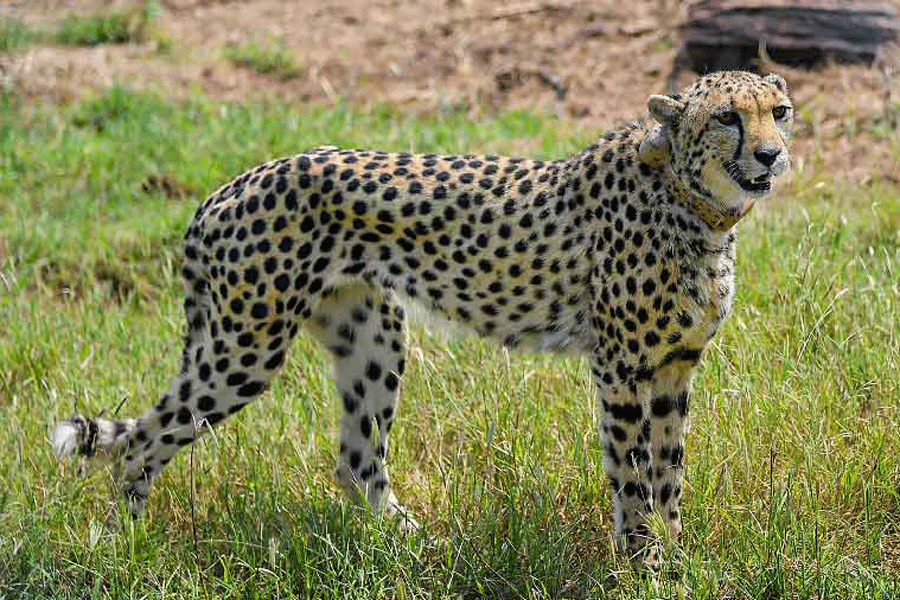The circumstances leading to the death of the South African male cheetah in the Kuno National Park on Tuesday remain a mystery after a preliminary post-mortem analysis on Wednesday said the cheetah had superficial external wounds but unhealthy internal organs.
A post-mortem report summary shared with experts associated with the project said the “external wounds on the back neck were superficial, only on the skin, not deep". However, it also said the cheetah’s lungs, heart, spleen, and kidney were “not in normal condition”.
Wildlife staff had spotted the cheetah housed within a fenced enclosure in Kuno with injuries on Tuesday at around 11am and the animal died at around 2pm. The site of the injuries on the neck had prompted some cheetah specialists to speculate whether a leopard had sneaked into the fenced enclosure and inflicted the injuries, but others suggested that a Namibian female also in the same enclosure had inflicted the injuries during a mating attempt.
"The death of the cheetah is currently under investigation and the details will be shared once the investigation is over,” the Union environment ministry said in a written response to queries from this newspaper seeking information about the immediate sequence of events leading to the death.
Neither the ministry nor a wildlife official associated with the project responded to specific queries about what treatment, if any, had been provided to the cheetah between 11am and 2pm.
The post-mortem summary has attributed the death to the injuries on a cheetah already ailing.
“On internal examination, lungs, heart, spleen and kidney were not found in normal condition and (appear) compromised. Heart was having chicken fat in the aorta and auricle. Kidney was pulpy and no demarcation was found between the cortex and medulla. Spleen was having emphysema and white nodules. Due to this compromised health condition, probably, it could not recover from the trauma caused by external injuries,” the report said.
Experts guiding India’s cheetah introduction project have said the report, which also noted that the cheetah was 43kg and underweight, raises more questions than it answers. For instance, why was the cheetah in a poor health condition and why did no one notice until the post-mortem?
The death on Tuesday was the fourth loss of an adult cheetah among the 20 that the environment ministry had brought into Kuno from Africa in efforts to introduce clusters of cheetah populations in the wild. Three cubs born in Kuno in March also died in May this year.
All the seven deaths have occurred within fenced enclosures of Kuno where wildlife biologists had expected the cheetahs to be safer than they would be in unfenced areas where they are exposed to predators such as leopards and other threats.
The deaths have led some experts to ask whether it is time for the National Tiger Conservation Authority, the agency implementing the project, to rethink the strategy of holding cheetahs captive for months in large fenced enclosures and releasing them in the wild in phases.
“No deaths have been recorded in free-ranging (unfenced) conditions. This suggests that the large enclosure and phased release approach adopted has been problematic,” a wildlife expert with extensive experience with cheetahs in Africa told The Telegraph.
The Union environment ministry had flown in eight cheetahs from Namibia in September last year and 12 more from South Africa in February this year. Although the cheetah introduction plan document had estimated Kuno can hold 20 cheetahs, project managers have released cheetahs into the wild in phases.
“In Africa, we do not employ this phased release approach for wild cheetah introduction,” the expert said, referring to the movement of cheetahs from one sanctuary into another. “Our cheetahs do a one-month quarantine in a small enclosure, then they are released into the free-ranging conditions.”
But the incidents in Kuno suggest that “micromanaging wild cheetahs” in small fenced areas ranging from 100-200 acres can lead to problems. But the expert said the project still has 80 per cent of the founding population and should be viewed as “still on track".
A Namibian cheetah had died in March from what appeared to be a kidney disorder that wildlife biologists say has been documented in the past in cheetahs under long-term captivity. A South African cheetah died in April from a cause not yet determined. A female cheetah had died in May after being attacked by a male cheetah during courtship.
Sections of wildlife biologists have since last October criticised the Indian government for what they have described as a rush to introduce cheetahs into the country without adequate preparations for the challenges the project would pose.
Some have argued that India lacks the vast open spaces that cheetahs in the wild require.










